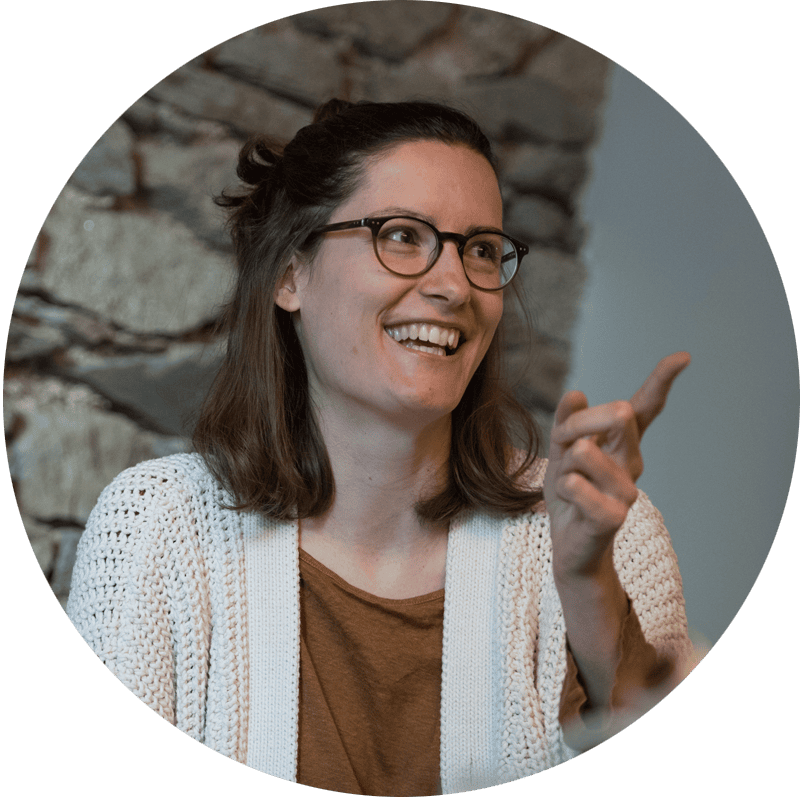Those of you who are interested in personal development may have heard about the enneagram. The enneagram is a very old approach that finds its roots in antiquity. It is a powerful tool for understanding yourself and improving your relationships with others.
When I discovered the enneagram, it really felt like if I had put new glasses on with the right correction. I suddenly saw my behaviour and personality in a completely different lens. Rather than putting me in a “box”, which can be the downside of personal development tools, the enneagram actually helped me see the box in which I had grown up.
Because the structure of our personality is just like a box. When we are faced with danger, or any situation that we perceive as threatening, we automatically activate a very strong defence system that protects the structure of our personality, and pushes the pain away. All of that is most often unconscious and completely automatic. Our defence system is this very sturdy box that protects our identity and nicely keeps our personality together. Especially as a kid, it has been very useful and has served us many times. However, this box can easily become a wall, because it maintains us in an automatic system with recurring thoughts, emotions and actions.
So, it is important to acknowledge the box in which we have grown up, and also to see outside of it. Because there are other people stuck in their very own boxes, out there. The enneagram actually says that there are 9 different lenses in which we see the world. There is so much to learn from this.
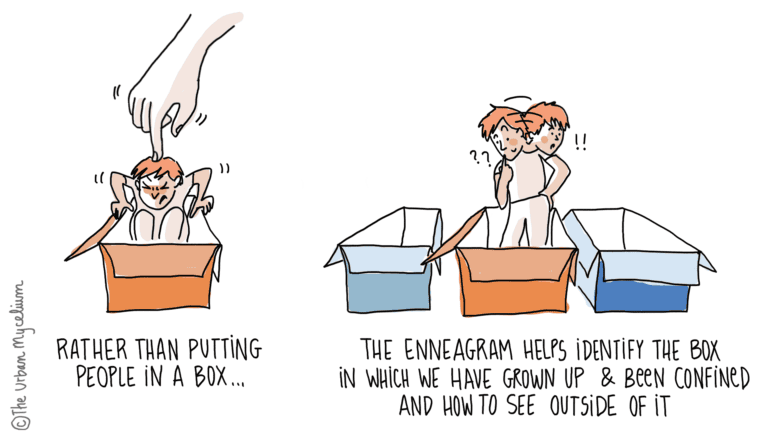
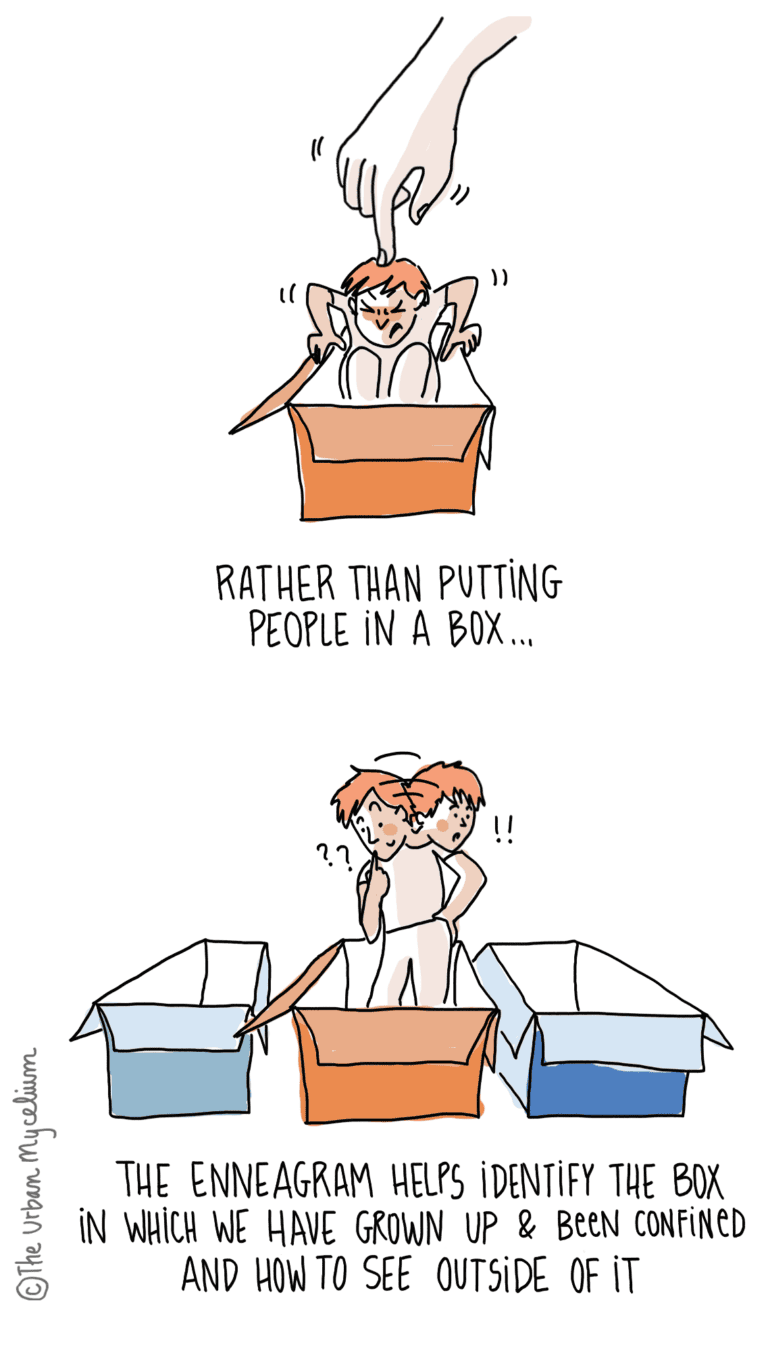
Alright, but what does it have to do with city making?
Well, cities are made of people. They are shaped by people, people with different lenses in which they see the world. How is our personality influencing the way we make cities? Are current cities fairly suited to the great diversity of our personalities? I find these questions fascinating. Exploring the intersection between urbanism and the psychology of personality not only can help make sense of the way we shape our environment, but it can also help us improve the way we make cities together, in turn creating a built environment that better suits our various personalities.
I would like to point out that the enneagram is a living approach, that you experience, more than you theorize. You can learn a lot about yourself by reading books and taking tests online, but you will always go in much more depth by practicing through internships and panels, where people who have found themselves in their enneagram type and instinct share live testimonies. If you are French speaking, I warmly encourage you to follow the trainings provided by Ennea 9, in Nantes, which provides transformative journeys grounded in the narrative tradition.
What is the enneagram?
Combining the 2 Greek words ennea (the number nine) and gramma (figure, diagram), the enneagram is a 9-point geometric symbol describing 9 types of personalities. Each of the 9 enneagram types has a different way of thinking, feeling and acting, with different behaviours and habits.
The enneagram is based on the combination of 2 principles:
- First, the fact that we each rely on three fundamental intelligence centres: head, heart and body. As we grow older, we develop each of these intelligence centres unevenly, and we specifically end up favouring one centre which will become dominant.
- Secondly, we are also all concerned with our three primal instincts: the self-preservation instinct, the sexual instinct, and the social instinct. They are present in each of us, but not in the same proportions.
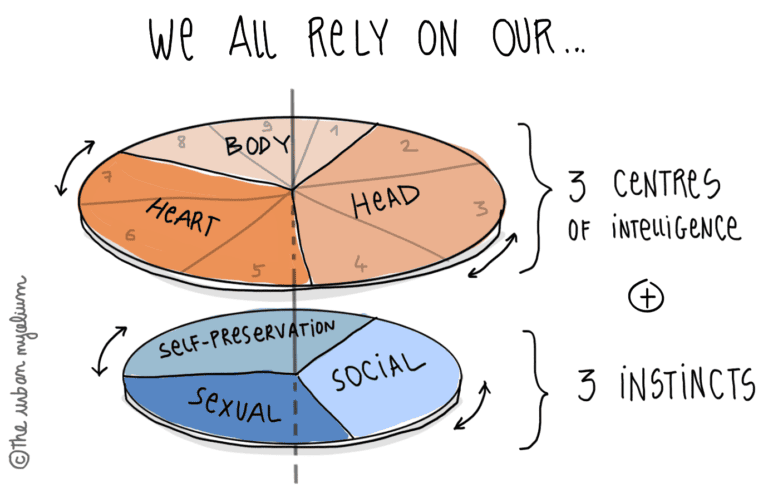
Before even identifying our type, the enneagram invites us to find out which is our dominant centre of intelligence (head, heart or body) and our dominant instinct (self-preservation, sexual or social), in order to know ourselves better and identify pathways to a better balance. The combination of our centre of intelligence and instinct is what Brigitte Riom-Tendron called an “archestyle”.
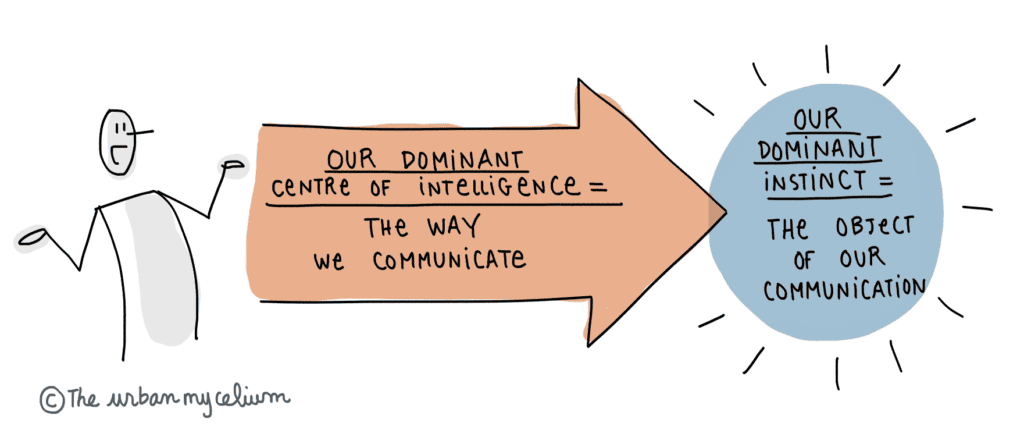
In this article, I will mostly talk about instincts. This is where our attention is focused in everyday life; where our main concerns are.
- The self-preservation instinct governs our need of material and physical security, including food, shelter, warmth, and family connections. People who have a dominant self-preservation instinct are very concerned about their close family (their “clan”). They enjoy staying at home with their family and close ones, but when they go out, they choose safe, comfortable, child-friendly places: a cosy café, a park or a playground, for example.
- The sexual instinct governs our sexuality, our intimate relationships and our vitality. People who have a dominant sexual instinct are concerned about their connection with the other one, with whom they seek exclusivity. The other one may be a lover, a friend, a colleague, or even an activity, a landscape or an object (computer, smartphone, etc.). In the city, you can find them in any place where they can have exclusive one-to-one connections with other people: restaurants and bars, for example. Or in places where they can enjoy vivid experiences: a connection with art in a museum, a walk with their dog in a park, an intense running session…
- The social instinct governs our needs to belong and to be part of a larger group: a company, associations, networks… People who have a dominant social instinct naturally like to participate in the life of the community and to contribute to the greater good. In the city, they like to be outside and get involved in a collective cause: neighbourhood, sports or social associations. The places they prefer are rather public places such as shared spaces, common rooms, third places, public spaces…
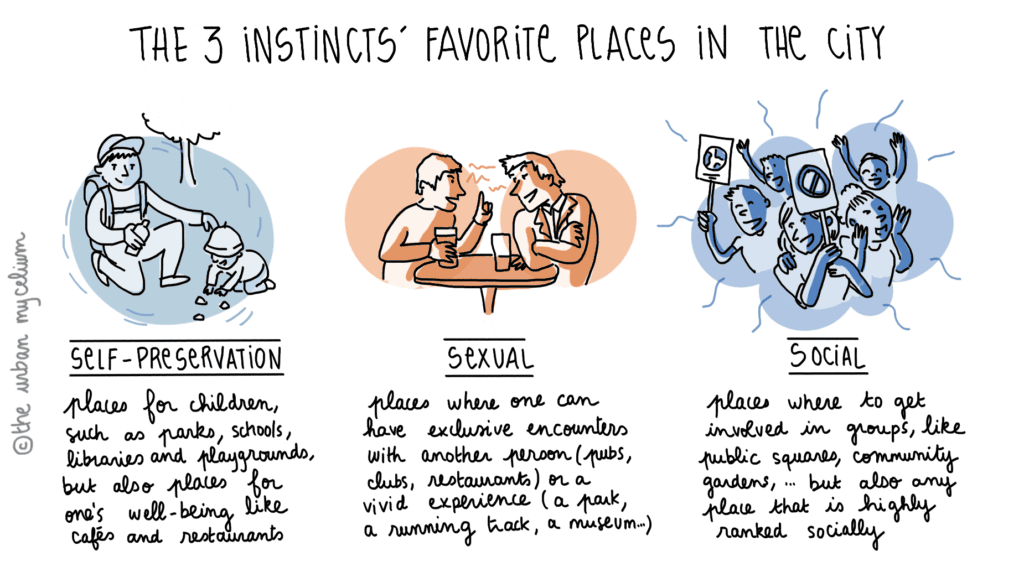
What the enneagram says about the participants of public participation processes
We have seen before that public participation was not for everyone. In public meetings, we often see the same profiles of people:
- Mostly white middle-age men, who are heterosexual, valid, who come from the middle or the upper class and have an education;
- Often, people who have retired from professional positions with high responsibilities;
- Often also, people with a strong civic commitment, already engaged in different associations or another form of activism.
In most of the workshops I facilitated, despite our best efforts, we always missed the parents of young children, single mothers, low-income people, people working at night, unemployed people, the homeless, racialized people, gender minorities, young children, teenagers, students, etc.
Beyond what I observed in practice, I realize now that the enneagram can shed new light on this recurring situation. And this is very enlightening.
In fact, not all 3 instincts enjoy participating in group workshops about the future of the city, on weekdays, in the evening… The great majority of participants actually are people with a dominant social instinct. They are the ones who feel concerned about social causes and everything that has to do with the progress of society. They naturally engage in activities that are aimed at improving the city.
A much smaller part of the participants are people with a dominant sexual instinct. They don’t participate because they enjoy working for a “greater world”, but for other reasons. For example, to follow their partner who is participating (maybe a social one?); or to fight for what is in their “power” (territory, knowledge, etc.). It can also be to check what is happening there: who is participating, what is the project… with the idea of challenging or questioning the status quo.
And in most cases, people with a dominant self-preservation instinct will not attend public meetings. They are not interested in this at all, unless the urban project threatens their immediate physical security (expropriation of their house, new construction at the end of their garden, etc.). And even in that case, they will usually have already anticipated this kind of situation from happening.
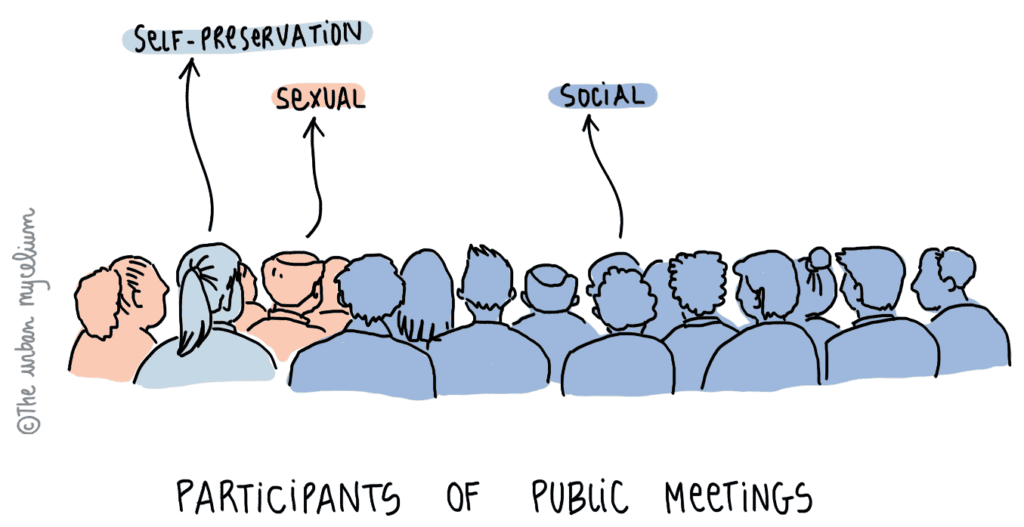
So, what does it mean?
- What it means, is that we are potentially excluding up to 2/3 of the different personality profiles that exist… meaning up to 2/3 of all the citizens!
- This could also explain why some people are systematically more difficult to reach and to get on board (beyond physical and structural limitations such as the distance to the meeting, the children to take care of, reduced mobility, the time of the meeting, etc.).
- Adding to that, analysing participants through the lens of the instincts actually shows that it will always be more difficult to engage with people who have a dominant self-preservation instinct, because they are not interested in this kind of things at all.
So, how can we be more representative in terms of instincts, knowing that our personality is not written on our forehead?
People with a dominant social instinct don’t need any enticement, they’ll usually come anyway. As for the two other instincts, the work is basically to rely on a more diverse range of encounters that better fit people’s personality and match their concerns and interests. Not everyone enjoys a group meeting!
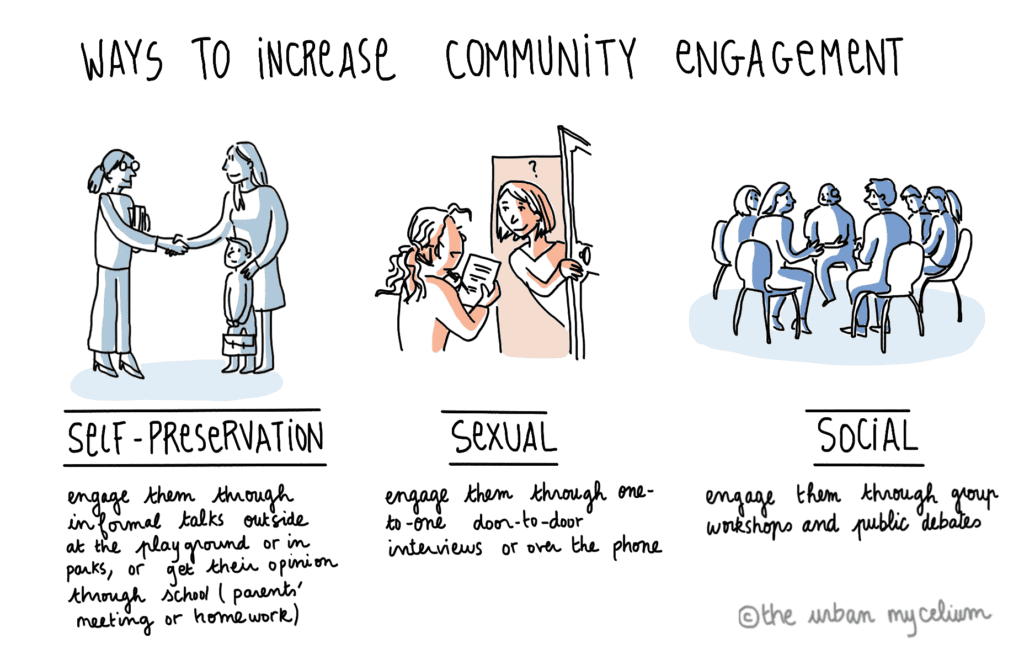
- People with a dominant self-preservation instinct: get their opinion on the city through informal discussions outside, with no commitment. You can interview parents at the playground or in a park, while the kids are playing. Another way is to organize a meeting at school with the parents; or to ask for the parents’ opinion through homework led by the children themselves.
- People with a dominant sexual or tete-a-tete instinct: get their opinion on the city through one-to-one interviews over the phone, or door-to-door; this way they are more likely to participate.
Again, not everyone enjoys a group meeting. Analysing public participation in urban projects with the lens of the enneagram shows how important it is to diversify the formats of participation in order to be representative of our various personalities.
But of course, it is obviously much more complex than that, and one blog article is not enough to describe the depths of the enneagram!

